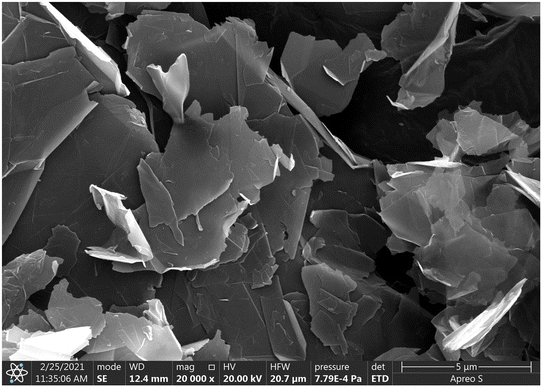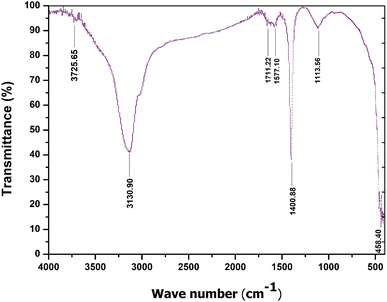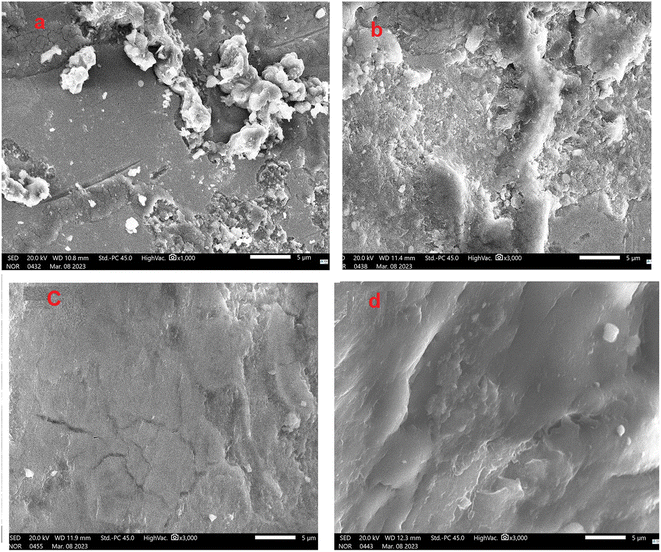 Open Access Article
Open Access ArticlePhysico-chemical and tribological properties of commercial oil – bio-lubricant mixtures dispersed with graphene nanoplatelets
Koteswara Rao Banavathua,
Kodanda Rama Rao Chebattina b,
V. Srinivas
b,
V. Srinivas *b,
Ch V. K. N. S. N. Moorthy
*b,
Ch V. K. N. S. N. Moorthy *cd and
Gandhi Pullagurab
*cd and
Gandhi Pullagurab
aDepartment of Mechanical Engineering, GITAM Deemed to be University, Visakhapatnam, India
bDepartment of Mechanical Engineering, GITAM Deemed to be University, Visakhapatnam, India 530045. E-mail: vsvas1973@yahoo.com
cDepartment of Mechanical Engineering, Vasavi College of Engineering, Hyderabad, India. E-mail: moorthy.chvknsn@nisantasi.edu.tr; krishna.turbo@gmail.com
dNisantasi University, Istanbul, Turkey
First published on 12th June 2023
Abstract
This study focuses on the physicochemical and tribological properties of bio-lubricants and commercial lubricant blends dispersed with graphene nanoplatelets. In the processing of the bio lubricant, special care was taken to ensure that the physicochemical properties do not deteriorate too much when the bio lubricant is blended with commercial oil. Calophyllum inophyllum (Tamanu tree) seed oil was used to prepare a penta-erythritol (PE) ester. The PE ester was mixed with commercial SN motor oil at 10, 20, 30 & 40% v/v concentrations. The oil samples are tested on a four-ball wear tester to see how well they perform under wear, friction, and extreme pressure conditions. The optimum blend of PE ester – commercial SN motor oil for the best performance is found in the first phase. Later the optimum blend of commercial oil and bio-lubricant is dispersed with graphene nanoplatelets in 0.025%, 0.05%, 0.1%, 0.25%, 0.5% and 1% weight fractions. A blend ratio of 30% bio-lubricant in commercial oil dispersed with 0.05% graphene nanoplatelets dramatically reduces friction and wear. During the extreme pressure test, commercial oil, and bio-lubricant blends performed better in load-carrying capacity and welding force, indicating an improved load-wear index. These improved properties due to the dispersion of graphene nanoplatelets could facilitate the use of a higher blend percentage of bio lubricant. Analysis of the worn surfaces after the EP test showed that bio lubricant, additives, and graphene worked together in the blend of bio lubricant and commercial oil.
1 Introduction
Due to the rapid development of technology in recent decades, the consumption of petroleum resources has increased dramatically. Engine oil is crucial in automobiles to prevent heat and corrosion due to friction. Several studies1–37 explored the commercial use of biobased oils. Ting and Chen34 proposed the possibility of producing new lubricants with esters from seed oils, thus minimizing toxicity and improving the biodegradability of engine oils over time. Lathi and Mattiasson23 showed that bio-based lubricants could replace petroleum-based oils. In addition, they have superior tribological properties, high viscosity index, and excellent lubricity. The former can probably replace mineral and synthetic oils when blended with commercial oils because the chemical structure of commercial oils and bio-lubricants is similar. Few studies1–30 have highlighted the potential of bioester-based lubricants as a supplement to lubricants. However, extensive efforts have been made to find a suitable replacement to petroleum-based oils in IC engines. In addition to their use in the automotive and aerospace industries, mineral oils are appropriately used in industrial applications, according to Mobarak et al.11,29 Hamid et al.12 have shown that bio-lubricants in combination with conventional petroleum-based lubricants can outperform commercial lubricating oils in terms of biodegradability and toxicity. These vegetable oils can act as wear inhibitors and friction modifiers due to their intense adsorption on lubricated surfaces. In their long-chain fatty acid composition, vegetable oils contain polar groups that are very efficient in interfacial and hydrodynamic lubrication conditions.1.1 Disadvantage of bio-lubricants
Although biodegradable oils have many advantages over conventional oils, they also have certain disadvantages. Oxidation of the lubricants due to hydrogen atoms in the esters makes them susceptible and limits their application at high temperatures. In addition, some authors,14,23,37 indicate that bio-lubricants are avoided as lubricants in automobiles due to their low load-carrying capacity. The load-carrying capacity of a lubricant is its ability to prevent wear and separate metal surfaces under heavy load and pressure. In numerous applications, such as gears, bearings and other mechanical systems subject to high loads, the load-carrying capacity of lubricants is a critical property. The load-carrying capacity of a lubricant is influenced by several factors, including base oil viscosity, additives and operating conditions. In general, base lubricants with a higher viscosity and certain types of additives, such as high-pressure additives, can improve the load carrying capacity of a lubricant.However, converting glycerol esters to sugar per-esters leads to high thermal stability. Several researchers14,37 suggested replacing the glycerol group with an alcohol group (polyol esters) to increase oxidation resistance and thermal stability. These results also show that two crucial properties, (1) the polyol-ester structure and (2) the extent of the fatty acid chain, affect the tribological properties under boundary lubrication conditions. Other researchers20–37 also suggested that these deficiencies can be overcome by dispersing various additives such as nanoparticles, tribological improvers, and friction modifiers. One of these nanomaterials is graphene nanoplatelets, an exceptional tribological performance additive. It is a two-dimensional carbon-based material with a large surface area and exceptional chemical stability. By forming nanorods on the sliding surface, Li et al.25 can produce super lubricity on the tribo-pair.
Guo et al.7,10 used the nanographene additives at 0.05, 0.1 and 0.5 wt% to disperse in polyalphaolefin-2 (PAO2) base oil to investigate the tribological properties. The PAO2 oil with the concentration of 0.05 wt% graphene nano-additives was the best oil for improving tribological properties (reduced friction and wear by 78% and 14.47%, respectively). The multi-layered nano-graphene additives were capable of withstanding steel ball loading. Their second study7,10 showed that a two-step approach to dispersing nano additives in synthetic ester biolubricant improved stability. The highest recorded reductions in friction and wear coefficients were 26 percent and 42.2 percent, respectively. Jason16 investigated the tribological properties of mineral oil-Pongamia oil blends with and without dispersion of graphene nanoplatelets using a four-ball tester to investigate wear resistance according to ASTM D4172 standard. The test results were improved by adding 0.05% GNPs in 15W-40 engine oil and Pongamia oil, reducing friction and wear by 17.8% and 12.3% for PO and 12% and 5.2% for MO, respectively. It was concluded that the deposition of GNPs on frictional surfaces can successfully protect and reduce friction and wear.
In all studies, they concluded that the addition of graphene nanoparticles formed a protective tribo-film at the interface, which reduced friction and wear.
1.2 Present studies
Most studies have focused on evaluating friction and wear properties rather than extreme pressure properties, which are critical for all engine oils. In addition, there is no information on how surface modification of graphene affects the improvement of properties. The current study focuses on analyzing the lubrication properties of a conventional lubricant blended with graphene nanoplatelets and a bio-lubricant (ester) of Calophyllum inophyllum oil (Tamanu oil). The commercial oil selected for the study is a 4-stroke motorcycle oil with zinc and phosphorus (ZDDP) based additives. For this experiment, a penta-erythritol (PE) based bio-lubricant was used because it has four ester groups and a long chain, both of which increase lubricity. Unlike previous studies in which PE ester contained 45–50 percent tetra-ester, in the current study, the process is carried out until a 100 percent long-chain tetra-ester is obtained, which would improve anti-friction properties. The synergistic effect of the mixture of PE ester in commercial oil and dispersed with graphene nanoplatelets is investigated. Due to the additives and dispersion of graphene, higher mixing ratios of 10, 20, 30 and 40 percent volume/volume were selected for mixing with commercial oil. Determining the optimum blend ratio for maximum performance was a priority. In addition, there is no information on how surface modification of graphene affects property improvement. In the current study, a four-ball tester is used to evaluate the lubricating properties. In 3-point contact, the lubricated balls form the boundary lubrication system. The method compares how well each oil performs in respect of friction, wear, and extreme pressure properties.2 Materials and methods
The Calophyllum inophyllum tree and its seeds are abundantly available in Asia, Africa, and parts of Australia. Graphene nanoplatelets with a purity of 99% were procured from M/s XG Graphene, USA. The graphene nanoplatelets were characterized using a FESEM, and the microscopic image is shown in Fig. 1.2.1 Processing of bio-lubricants
The seed oil was removed from the Calophyllum inophyllum seeds. The Calophyllum fatty acids pentaerythritol (30.44 g, 0.223 mol), p-toluenesulfonic acid (2.51 g on a 1% basis), and 300 ml of solvent (toluene or hexane) were mixed and refluxed to give PE ester. Post-reaction, the mixture was cooled, and the solvent was recovered under vacuum. The reactants were combined with an aqueous solution of sodium bicarbonate and ethyl acetate, and the mixture was shaken in a shaker for 30 minutes. The organic layer of the reaction was removed, cleaned with water, and dried in vacuum on anhydrous sodium sulfate. Basic alumina column chromatography was used to purify the crude esters to make them PE esters with hexane and ethyl acetate as eluents.2.2 Preparation of test oils
The commercial lubricant selected for the current study is an SN-grade motor oil with additives. The chemical profile of the lubricant is shown in Table 1.| Chemical element | Method of testing as per ASTM | Quantity |
|---|---|---|
| Phosphorous, ppm | ASTM D 5185 | 949 |
| Zinc, ppm | ASTM D 5185 | 1038 |
| Calcium, ppm | ASTM D 5185 | 1863 |
| Sulfur, % wt | ASTM D 4951 | 0.284 |
The bio-lubricant pentaerythritol (PE) ester is blended with the commercial lubricant in volume percentages of 10, 20, 30 and 40% and stirred thoroughly to obtain a uniform mixture.
2.3 Surface modification of graphene nanoplatelets for stable dispersion in fuels
Surface modification of nanoparticles is a recognized technique to improve the dispersion stability of nanomaterials. It is crucial to design the surface structure according to the type of nanomaterial and liquid medium. To improve the dispersion stability of nanoparticles in lubricating fluids and prevent agglomeration, the particle surface must be modified with polymeric surfactants or other modifiers to create an effective repulsive force between the nanoparticles. The surfactant should not affect the wear and friction properties of the lubricant.![[double bond, length as m-dash]](https://www.rsc.org/images/entities/char_e001.gif) O stretching at wave numbers 1711.22 cm−1 and 1577.09 cm−1, indicating polar groups. These polar groups provide good dispersion of graphene nanoplatelets in the oil.
O stretching at wave numbers 1711.22 cm−1 and 1577.09 cm−1, indicating polar groups. These polar groups provide good dispersion of graphene nanoplatelets in the oil.
3 Testing for tribological and physicochemical properties
3.1 Tribological properties using four ball tribometer
The four-ball tester is an indispensable tool for lubricant production and quality control. Manufacturers can ensure that their products meet their performance requirements by testing lubricants at various stages of development. The friction and wear properties of lubricants are evaluated using the four-ball tester, which measures the coefficient of friction, diameter of the wear scar, and weld point. These properties are important indicators of a lubricant's ability to reduce friction and wear, thereby extending the life of mechanical components and reducing maintenance costs.In a four-stroke motorcycle engine, the lubricating oil is both engine oil and transmission oil. Therefore, the it must withstand high gear loads while reducing friction and wear. Wear, friction and extreme pressure properties were tested according to ASTM standards. Three lubricant-soaked steel balls, each 0.5 inches in diameter, are used in each experiment. Three-point contact occurs when the “top ball” applies pressure to the three clamped balls.
Table 2 shows all test conditions for wear, friction, and EP. During the ASTM D 4172 wear test, the upper ball rotates against the three lower balls with a certain force, causing the lower balls to wear. The diameter of the wear scar is determined by taking the average of the scar diameters of the three balls. According to ASTM D 5183, friction tests are performed under various loading conditions to simulate an automotive internal combustion engine.
| Wear test (ASTM D4172) | |
|---|---|
| The chamber temperature | 75 ± 1 °C |
| Duration of test | One hour |
| Top ball rotating speed | 1200 ± 12 RPM |
| Applied load | 392.4 N (40 kgf) |
| Friction test (ASTM D5183) | |
|---|---|
| The chamber temperature | 75 ± 1 °C |
| Test time | One hour (for wear-in) |
| The friction test is then performed until the seizure load | |
| Top ball rotating speed | 600 ± 6 RPM |
| Applied load | 392.4 N (40 kgf) (during wear in) |
| (In the friction test, the load is initially set at 98.1 N (10 kgf) and increased by 98.1 N (10 kgf) every ten minutes until the seizure load is reached) | |
| Extreme pressure test (ASTM D 2783) | |
|---|---|
| The chamber temperature | Ambient |
| Test time | 10 tests, each lasting 10 s at each load |
| Top ball rotating speed | 1760 ± 10 RPM |
| Applied load | Initially, 313.9 N (32 kgf) and gradually increasing the load up to the welding point |
With the introduction of high-performance motorcycles, the engine load has increased dramatically. Therefore, the wear performance of engine oil at a load of 588.6 N (60 kgf) was also evaluated to determine the influence of combining bio lubricant with commercial oil and graphene nanoplatelets at high loads. Following ASTM D 5183 guidelines, friction tests were conducted under various loading situations that mimic an automobile's internal combustion engine. The initial run-in period was performed under the parameters listed in Table 3. At the end of the run-in period, the used engine oil is drained and the ball cup and the run-in steel balls are cleaned without repositioning the balls. 10 ml of new lubricant is added to the ball cup without overturning the worn balls. During the test, 98.1 N is repeatedly applied at 10 minutes intervals. The load is further increased at the end of the 10 minutes until a dramatic increase in frictional torque is observed, indicating a seizure.
| Load, N | Compensation/actual scar diameter, microns |
|---|---|
| 157 | 221 |
| 196.2 | 238 |
| 235.4 | 253 |
| 313.9 | Actual values are taken to calculate the results |
| 392.4 | |
| 490.5 | |
| 588.6 | |
| 784.8 | |
| 1177.2 | |
| 1373.4 | |
| 1569.6 | |
| 1962 |
According to ASTM D 2783, welding force and load-wear index evaluate the lubricant's capabilities under extreme pressure. In a series of ten tests, each lasting 10 seconds, the welding load was measured where a weld is formed from all four balls under extreme pressure. In terms of welding force and load wear index, the lubricant properties were tested under extreme pressure per ASTM D 2783. Ten tests were conducted, each lasting ten seconds, to measure the welding force. The load was increased for each test until a weld formed from all four balls under extreme pressure. The load-wear index measures the performance of the engine oil at loads from incipient seizure to the load below weld load. The initial load for the first ten series of tests is 313.9 N (32 kgf). Subsequent tests were performed with increasing weights until the four balls were welded under high pressure.
Following the precedent, the corrected load is calculated for each of the 10 readings for weights less than 313.9 N (32 kgf) by utilizing the compensatory scar diameter. The following formulas are used to calculate the load wear index.
| Corrected load = (PDh)/X | (1) |
| Load wear index (LWI) = (A/10), (kgf) | (2) |
3.2 Metallographic investigation
Using a metallurgical microscope, the wear profile of the worn balls preceding to the weld load in the EP test was examined. The worn surfaces are examined with EDX analysis. The combined effect of bio-lubricant esters, graphene nanoplatelets, and commercial oil additives may be ascertained based on the deposits on worn balls.4 Optimization of blend percentage of bio lubricant for best results
Penta-erythritol (PE) based bio-lubricant stock is taken and mixed with commercial oil in a volume percentage of 10%, 20% and 30%. The test oils are tested for physicochemical properties and tribological properties to assess the optimum blend percentage.4.1 Evaluation of physicochemical properties commercial oil – bio lubricant blends
The physicochemical properties of bio-lubricants play a crucial role in maintaining their tribological properties. Degradation of properties due to the inadequate synthesis of bio-lubricants may result in inferior performance. The properties as shown in Table 4 have been investigated using established test procedures and are within the acceptable range. As specified by the SAE standard, all test lubricants have an acid value well below 1.5 mg KOH per gram of oil. At blend proportions greater than 30 percent, the viscosity and viscosity index decrease slightly, but the viscosity index remains above 90, as specified for engine oils.| Properties | Acid number (mg of KOH per g oil) | Viscosity at 40 °C (cSt) | Viscosity at 100 °C (cSt) | Viscosity index | Copper strip corrosion |
|---|---|---|---|---|---|
| Methods | ASTM D 664 | ASTM D 2245 | ASTM D 2245 | ASTM D 2270 | ASTM D 130 |
| PE ester | 0.28 | 23.85 | 6.68 | 263 | 1(b) |
| Commercial motor oil | 1.05 | 137.22 | 15.72 | 119 | 1(a) |
| Commercial oil + 10% PE ester | 0.99 | 134.33 | 15.42 | 119 | 1(a) |
| Commercial oil + 20% PE ester | 0.97 | 132.5 | 14.92 | 114 | 1(a) |
| Commercial oil + 30% PE ester | 0.91 | 130.23 | 13.75 | 102 | 1(b) |
Copper strip corrosion tests on all test samples conducted at 50 °C for three hours showed that corrosion protection was excellent up to a 20 percent blend ratio and comparable to commercial lubricants. On the corrosion standard, the corrosion resistance for a mixture of 20 and 30 percent is also rated 1a and 1b respectively, which is considered good and sufficient.
4.2 Tribological properties
For all tribological properties tests, ten iterations of the tribological tests were performed and the average values were reported. The data analysis of the wear tests proves the synergy of PE ester with the additives of the commercial oil and shows that the tribological properties were greatly improved as can be seen from Table 5. ASTM D4172-compliant wear tests conducted at 392.4 N (40 kgf) and 588 N (60 kgf loads) with different test oils were shown in Table 5. Up to a mixing ratio of 20%, the performance of commercial lubricants with PE ester is ideal, but the performance decreases above 30%.| Wear test | ||
|---|---|---|
| Test oils | Wear scar diameter, microns | |
| PE ester (bio lubricant) | 682.3 | 1013.4 |
| Commercial oil | 410.32 | 498.24 |
| Commercial oil + 10% bio lubricant | 395.31 | 472.34 |
| Commercial oil + 20% bio lubricant | 411.11 | 500.36 |
| Commercial oil + 30% bio lubricant | 532.32 | 658.34 |
| Friction test | ||
|---|---|---|
| Test oil | Coefficient of friction | Seizure load, N |
| PE ester | 0.0713 | 882.9 |
| Commercial oil | 0.0987 | 1177.2 |
| Commercial oil + 10% bio lubricant | 0.0823 | 1177.2 |
| Commercial oil + 20% bio lubricant | 0.0842 | 1275.3 |
| Commercial oil + 30% bio lubricant | 0.1162 | 1079.1 |
| Extreme pressure test | ||
|---|---|---|
| Oil | Weld load, N | Load wear index |
| Commercial oil | 1569.6 | 30.17 |
| Commercial oil + 10% bio-lubricant | 1569.6 | 32.3 |
| Commercial oil + 20% bio-lubricant | 1569.6 | 33.7 |
| Commercial oil + 30% bio-lubricant | 1373.4 | 26.19 |
In friction tests, blending commercial oil with PE ester up to 20 percent by volume significantly improved wear and friction properties because the ester has a lower coefficient of friction than commercial oil. The lubricant's efficiency is highly dependent on the frictional load during the friction test. The friction test results for a range of test oils are shown in Fig. 3 as a coefficient of friction and seizure load.
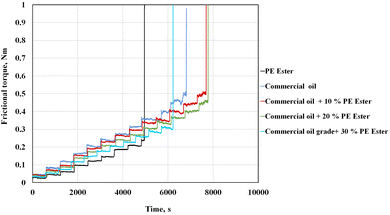 | ||
| Fig. 3 Variation of friction torque with the time during friction test of commercial oil with PE ester blends. | ||
As indicated, the PE ester had a very low coefficient of friction, but the major disadvantage of biolubricants is their low seizure load of 90 kgf. Adding 10 or 20 percent PE ester to a commercial lubricant significantly increases the seizure load and coefficient of friction. The frictional torque is in the same range for all lubricants at low loads, as shown in Fig. 3. Nevertheless, as the load increases, the frictional torque is largely the same between the commercial lubricant and its blends. At a blend percentage of 20%, the frictional torque decreased with increasing load, resulting in premature failure of the ester compared to the commercial oil.
In the extreme pressure test, the admixture of PE ester up to 20% by volume improves the weld load as well as load wear index. In the extreme pressure test, shown in Fig. 4 up to the ultimate point of non-seizure load (C), all combinations of commercial oil with 10, 20, and 30 percent bio-lubricants performed excellently, indicating that they are effective at lower loads. The blends with 20 and 30 percent PE esters showed a rapid surge in the wear scar diameters in the zone of the early seizure zone (C–D) and the immediate seizure zone (D–E), which affected both load-wear index and weld load. The improvement in the load wear index can be attributed to the reduced friction in the non-seizure and immediate seizure regions (Fig. 4) due to the presence of esters.
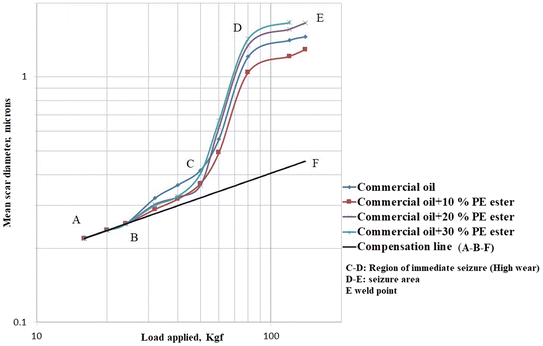 | ||
| Fig. 4 Variation of WSD with the applied load during the EP test for commercial oils containing different PE ester blends. | ||
5 Effect of dispersion of graphene nanoplatelets
After the tests in the previous section with the mixture of commercial oil and biolubricant, it was found that 20% blend gave the best results, followed by 30% blend. In order to evaluate the influence of the dispersion of graphene nanoplatelets on the tribological properties as well as blending percentage, commercial oil was first mixed with 20% biolubricant and the test cycle consisting of the evaluation of the physicochemical properties and the tribological properties was carried out. For this, the graphene nanoplatelets are dispersed in weight fractions of 0.025%, 0.05%, 0.1%, 0.25%, 0.5% and 1%.5.1 Physicochemical properties of test oils dispersed with graphene nanoplatelets
The physicochemical properties were initially carried out on commercial oil mixed with 20% biolubricant and dispersed with graphene nanoplatelets. The results are reported in Table 6. The viscosity and viscosity index change significantly, even though the acid number and copper strip corrosion results remain unchanged, as shown in the Table 6. Increasing the concentration of nanoparticles in a liquid usually leads to an increase in viscosity.| Properties | Acid number (mg of KOH per g oil) | Viscosity at 40 °C (cSt) | Viscosity at 100 °C (cSt) | Viscosity index | Copper strip corrosion |
|---|---|---|---|---|---|
| Methods | ASTM D 664 | ASTM D 2245 | ASTM D 2245 | ASTM D 2270 | ASTM D 130 |
| Commercial oil + 20% PE ester | 0.97 | 114.5 | 13.91 | 116 | 1(a) |
| Commercial oil + 20% PE ester + 0.025% GNPs | 0.97 | 115.64 | 13.93 | 120 | 1(a) |
| Commercial oil + 20% PE ester + 0.05% GNPs | 0.96 | 116.15 | 14.02 | 120 | 1(a) |
| Commercial oil + 20% PE ester + 0.1% GNPs | 0.96 | 119.77 | 14.36 | 120 | 1(a) |
| Commercial oil + 20% PE ester + 0.25% GNPs | 0.91 | 136.68 | 15.12 | 112 | 1(a) |
| Commercial oil + 20% PE ester + 0.5% GNPs | 0.9 | 154.13 | 15.58 | 103 | 1(a) |
| Commercial oil + 20% PE ester + 1% GNPs | 0.9 | 168.58 | 16.01 | 97 | 1(a) |
During the corrosion test, the weight percentage of graphene nanoplatelets has a negligible effect. Copper strip corrosion tests on all test samples conducted at 50 °C for three hours revealed that all test oils dispersed with graphene nanoplatelets provided outstanding corrosion protection.
Nanomaterials, especially graphene nanoplatelets and carbon nanotubes, have a larger surface area to volume ratio, which leads to increased interactions with the surrounding liquid molecules, thus increasing viscosity. In addition, commercial oil contains some additives to improve viscosity. This domino effect resulted in a progressive increase in the viscosity of the test oils as the weight fraction of graphene nanoplatelets was increased. This led to a progressive decrease in the viscosity index.
However, with the dispersion of graphene nanoplatelets in the range of 0.025 to 0.1%, viscosity improved at both 40 °C and 100 °C, so the viscosity index remained well above 100, indicating excellent oil properties in this temperature range.
5.2 Tribological properties of test oils dispersed with graphene nanoplatelets and optimization of weight fraction
The wear, friction, and extreme pressure properties are reported in the following Table 7. It can be seen from Table 7, there is a deterioration in the tribological properties of the test oils when the weight fraction of graphene nanoplatelets is increased beyond 0.1%. The wear, seizure load and friction coefficient rapidly increased when the concentration increased beyond 0.1%. The weld load and load wear index also sharply decreased with the addition of graphene nanoplatelets beyond 0.1%.| Test oil | Wear scar diameter at 392.4 N load | Friction coefficient | Seizure load in friction test, N | Weld load, N | Load wear index |
|---|---|---|---|---|---|
| Commercial oil + 20% bio-lubricant | 0.411 | 0.0842 | 1177.2 | 1765.8 | 33.7 |
| Commercial oil + 20% bio-lubricant + 0.025% graphene nanoplatelets | 0.389 | 0.0965 | 1177.2 | 1765.8 | 37.3 |
| Commercial oil + 20% bio-lubricant + 0.05% graphene nanoplatelets | 0.395 | 0.0803 | 1275.3 | 1765.8 | 40.3 |
| Commercial oil + 20% bio-lubricant + 0.1% graphene nanoplatelets | 0.413 | 0.0781 | 1275.3 | 1765.8 | 38.6 |
| Commercial oil + 20% bio-lubricant + 0.25% graphene nanoplatelets | 0.458 | 0.1068 | 1079.1 | 1569.6 | 27.8 |
| Commercial oil + 20% bio-lubricant + 0.5% graphene nanoplatelets | 0.458 | 0.1237 | 882.9 | 1373.4 | 24.6 |
| Commercial oil + 20% bio-lubricant + 1% graphene nanoplatelets | 0.481 | 0.1472 | 784.8 | 1373.4 | 23.1 |
When the blends of bio-lubricant and commercial oil are dispersed with 0.05% of graphene nanoplatelets, better results were observed and it was found that a blend percentage up to 30% gives the best results. This is where the benefit of dispersing graphene nanoplatelets becomes apparent. Dispersion of GNPs leads to a decrease in the coefficient of friction and an increase in the scuffing load up to a blend fraction of 30%, as shown in Fig. 5. At a mixing fraction of more than 30%, the scuffing load decreases, and the friction coefficient increases. Greater synergy is achieved with the dispersion of graphene nanoplatelets, and the wear scar is even low, indicating the best wear protection. With the dispersion of graphene nanoplatelets, the optimum percentage of PE ester incorporation increased to 30 percent for the best wear protection.
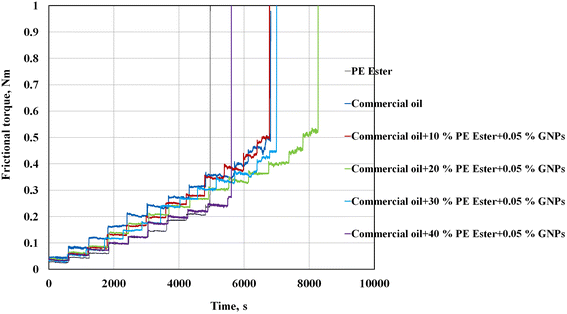 | ||
| Fig. 5 Variation of friction torque with time in a friction test of commercial oil with PE ester blends containing 0.05% of GNPs. | ||
In the extreme pressure testing, it can be seen from Fig. 6a and b, when the weight fraction is increased beyond 0.1%, there is a rapid increase in the wear scar in the immediate seizure region resulting in a sharp decrease in the load wear index (Table 7). This is due to the ripple effect caused by additives and viscosity modifiers present in the test oils. The test might have differed if pure base oil is used instead of commercial oil.
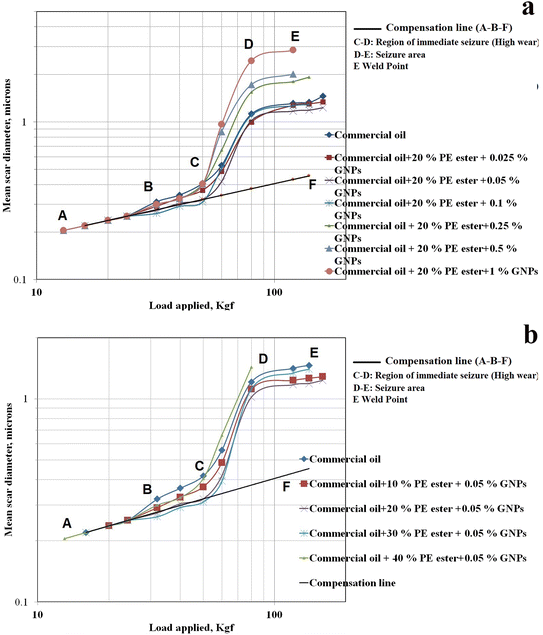 | ||
| Fig. 6 Variation of WSD with the applied load during the EP test for commercial oil with PE ester blends containing (a) varying percentages of GNPs and (b) 0.05% GNPs. | ||
In EP tests, for lubricating oil blends with 0.05% GNPs as can be seen from Fig. 6b, the early seizure zone (C–D) and the immediate seizure zone (D–E) had smaller wear scar diameters resulting in higher load wear indices. Owing to the best tribological performance of the blends with 0.05% GNPs after seizure load, the load-wear index increased for the 30% bio-lubricant blend with 0.05% GNP, with the weld load remaining the same as that of the commercial oil. This was due to the synergistic effect of the esters, commercial oil additives, and graphene nanoplatelets, which increased surface lubricity.
An increase in the weight fraction of nanomaterials causes the lubricant to have an excessive viscosity, which prevents the formation of a thin and uniform lubricating film, resulting in inadequate lubrication and increased wear. In addition, a higher percentage of nanomaterials increases the likelihood of particle–particle interactions that can form transient clusters within the fluid, thereby increasing its viscosity. This causes nanomaterials to accumulate near the fluid flow's boundaries, forming a dense layer that impedes the movement of fluid molecules, thereby increasing the wear of the surfaces. The results indicate that the optimal weight fraction of graphene nanoplatelets for optimal performance lies between 0.025 and 0.1%, with 0.05% yielding the finest results.
6 Results of the metallographic test
Commercially available lubricants contain sulfur- and ZDDP-based additives that react with metallic surfaces under high pressure to form iron phosphides and iron sulfides. As a result, these metal compounds form a chemical layer that reduces friction and wear, reducing the risk of component seizure and subsequent welding under high loads. The worn balls in a test before the welding load during the EP test were examined with a metallurgical microscope for the structure of the worn surfaces. Fig. 7 shows the metallographic image of the worn EP test balls collected before weld load when commercial oil is mixed with 20% and 30% bio lubricant and the corresponding oil dispersed with graphene.It has been demonstrated that base oil blended with 20% ester and base oil mixed with 20% ester and 0.05% graphene perform admirably. In all cases, the wear scar is reduced, and under extremely high pressure, the esters can even stop abrasive wear. Because of the combined effects of esters, commercial oil additives, and graphene, wear scars in oils mixed with graphene are small in diameter and depth. Larger concentrations are ineffective, as evidenced by the slight abrasive wear in oil containing 30% PE esters.
A scanning electron microscope with an EDS detector was used to examine metallographic deposits on the worn surfaces of the spheres. To determine how much of each element was deposited on the worn ball's surfaces, an EDS analysis of the worn balls from tests with commercial lubricant, commercial lubricant – PE ester blend, and graphene dispersed commercial oil – PE ester blend (see Fig. 8a–c).
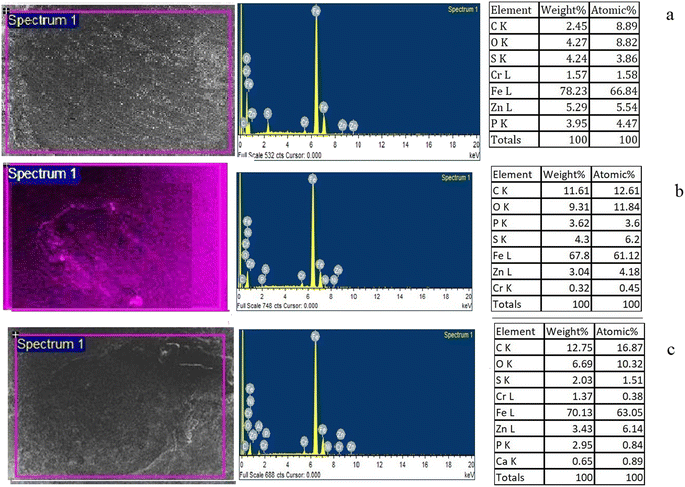 | ||
| Fig. 8 EDX spectrum of the worn ball in the EP test with (a) commercial oil, (b) commercial oil with 20% PE ester, and (c) commercial oil with 20 percent PE ester with and 0.05% graphene dispersion. | ||
The addition of nanomaterials to lubricants improves their lubricating properties by increasing their wear resistance, reducing friction and increasing their load-carrying capacity. On the other hand, lubricant additives are chemical compounds added to the base lubricant to improve its performance in various ways. These include increasing viscosity, reducing wear and preventing corrosion by forming a protective layer over contact surfaces. A synergistic effect can occur when lubricant additives are combined with nanomaterials in nano lubricants. This means that the additives and nanoparticles have an effect greater than the sum of their individual effects. This is because nanoparticles can help anchor the additives to the metal surface, resulting in a more stable and effective lubricating layer. In addition, nanoparticles can act as lubricant additives by forming a protective layer on metal surfaces and reducing friction and wear. This is especially true for nanomaterials with a high surface-to-volume ratio, such as graphene and other two-dimensional materials.
Commercial oil has a sulphur and zinc dialkyl dithiophosphate (ZDDP) as additives, which minimizes the risk of seizure on the surface of worn balls. Sulfur and zinc are also included in the depositions on the balls. There is a good chance that the EDX spectrum will contain carbon due to the combustion products. Commercial oil with 20 percent PE ester and 0.05% graphene dispersed commercial oil with 20 percent PE ester are shown in Fig. 8b and c, respectively. Due to the additions of the lubricant, the tribofilm of the surface contains greater concentrations of sulfur, calcium, and carbon deposits than those seen in the EDX spectrum of the worn ball in a test with commercial oil (zinc and phosphorus). Due to the deposition of esters on the contact surfaces, there was less friction between them, increasing the seizure and welding load.
7 Conclusions
(1) The tribological properties were improved without deteriorating the physical and chemical properties of the mixtures when the PE ester was added to the engine oil at a concentration of 10 and 20 percent by volume. But, the viscosity and viscosity index of the engine oils decreases when the blend percentage is above the recommended level.(2) The wear and friction coefficients of the test oils are significantly reduced when PE ester is added up to 20% of the mixing volume. The extreme pressure performance improved with higher weld load and wear index.
(3) The best results were obtained by mixing 20% PE ester with commercial oil without dispersing graphene nanoplatelets.
(4) The dispersion of graphene nanoplatelets up to 0.1% weight fraction significantly reduced wear and friction thereby increasing the weld load and load wear index.
(5) An optimum concentration of 0.05% gives the best results. Any increase in the concentration of GNPs beyond 0.1% is found to have deteriorated viscosity index, wear resistance, weld load and load wear index due to increased friction.
(6) Due to the improved tribological properties, the ideal mixing ratio of PE ester in commercial oil with the dispersion of 0.05% graphene nanoplatelets can be increased to 30%.
(7) Metallographic studies using FESEM – EDX analysis indicate an interaction between esters, graphene nanoplatelets and commercial oil additives, which may explain why the blends perform better.
(8) The excellent property enhancement with 0.05% graphene nanoplatelets is due to its good synergy with the additives in the lubricant. On the other hand, pure base oils without viscosity improvers, anti-wear, or severe pressure additives may produce distinct results when dispersed with 0.05% graphene nanoplatelets and necessitate higher graphene weight fractions.
Data availability
The data used to support the findings of this study are included within the article.Conflicts of interest
The authors affirm that they have no known financial or interpersonal conflicts that would have appeared to impact the research presented in this study.Acknowledgements
The tests were carried out with the cooperation of Hindustan Petroleum Corporation Ltd, which the authors sincerely acknowledge. The authors thank Andhra University Visakhapatnam for helping with the characterization.References
- A. Adhvaryu and S. Z. Erhan, Tribological studies of thermally and chemically modified vegetable oils for use as environmentally friendly lubricants, Wear, 2004, 257, 359–367 CrossRef CAS.
- N. A. M. Aziz, Y. Robiah, R. Umer, W. Nurin and M. Zulkifli, Temperature effect on tribological properties of polyol ester-based environmentally adapted lubricant, Tribol. Int., 2016, 93, 43–49 CrossRef CAS.
- S. S. N. Azman, N. W. M. Zulkifli, H. Masjuki, M. Gulzar and R. Zahid, Study of tribological properties of lubricating oil blend added with graphene nanoplatelets, J. Mater. Res., 2016, 31(13), 1932–1938 CrossRef CAS.
- J. M. L. Del Río, M. J. Guimarey, J. I. Prado, L. Lugo, E. R. López and M. J. Comuñas, Improving the tribological performance of a biodegradable lubricant adding graphene nanoplatelets as additives, J. Mol. Liq., 2022, 345, 117797 CrossRef.
- S. Z. Erhan and S. Asadauskas, Lubricant base stocks from vegetable oils, Ind. Crops Prod., 2000, 11, 277–282 CrossRef CAS.
- Z. Fuadi, D. Rahmadiawan, R. Kurniawan, F. Maulana, H. Abral, N. Nasruddin and M. Khalid, Effect of Graphene Nanoplatelets on Tribological Properties of Bacterial Cellulose/Polyolester Oil Bio-Lubricant, Frontiers of Mechanical Engineering, 2022, 8, 810847 CrossRef.
- Y. B. Guo and S. W. Zhang, The tribological properties of multi-layered graphene as additives of PAO2 oil in steel–steel contacts, Lubricants, 2016, 4(3), 30 CrossRef.
- M. H. Hasnul, N. W. Mohd Zulkifli, M. Hassan, S. A. Zulkifli, M. N. A. Mohd Yusoff and M. Z. Zakaria, Synergistic behavior of graphene and ionic liquid as bio-based lubricant additive, Lubricants, 2021, 9(5), 46 CrossRef CAS.
- N. J. Fox and G. W. Stachowiak, Vegetable oil-based lubricants—a review of oxidation, Tribol. Int., 2007, 40, 1035–1046 CrossRef CAS.
- Y. B. Guo and S. W. Zhang, The tribological properties of multi-layered graphene as additives of PAO2 oil in steel–steel contacts, Lubricants, 2016, 4(3), 30 CrossRef.
- M. Habibullah, H. H. Masjuki, M. A. Kalam, A. M. Ashraful, M. A. Habib and H. M. Mobarak, Effect of bio-lubricant on tribological characteristics of steel, Procedia Eng., 2014, 90, 740–745 CrossRef CAS.
- H. Hamid, T. Yunus, U. Rashid, T. S. Y. Choong, S. Ali and A. M. Syam, Synthesis of high oleic palm oil-based trimethylolpropane esters in a vacuum operated pulsed loop reactor, Fuel, 2016, 166, 560–566 CrossRef CAS.
- M. H. Hasnul, N. W. Mohd Zulkifli, M. Hassan, S. A. Zulkifli, M. N. A. Mohd Yusoff and M. Z. Zakaria, Synergistic behavior of graphene and ionic liquid as bio-based lubricant additive, Lubricants, 2021, 9(5), 46 CrossRef CAS.
- L. Havet, J. Blouet, V. F. Robbe, E. Brasseur and D. Slomka, Tribological characteristics of some environmentally friendly lubricants, Wear, 2011, 248, 140–146 CrossRef.
- E. K. Heikal, M. S. Elmelawy, A. K. Salah and N. M. El-basuny, Manufacturing of environment friendly biolubricants from vegetable oils, Egypt. J. Pet., 2017, 26, 53–59 CrossRef.
- Y. J. J. Jason, H. G. How, Y. H. Teoh, F. Sher, H. G. Chuah and J. S. Teh, Tribological behaviour of graphene nanoplatelets as additive in pongamia oil, Coatings, 2021, 11(6), 732 CrossRef CAS.
- N. Jayadas and K. Nair, Coconut oil as base oil for industrial lubricants-evaluation and modification of thermal, oxidative and low temperature properties, Tribol. Int., 2006, 39, 873–878 CrossRef CAS.
- K. Kamalakar, A. K. Rajak, R. B. N. Prasad and M. S. L. Karuna, Rubber seed oil-based biolubricant base stocks: a potential source for hydraulic oils, Ind. Crops Prod., 2013, 51, 249–257 CrossRef CAS.
- S. S. K. Kiu, S. Yusup, C. V. Soon, T. Arpin, S. Samion and R. N. M. Kamil, Tribological investigation of graphene as lubricant additive in vegetable oil, J. Phys. Sci., 2017, 28, 257 CrossRef CAS.
- D. R. Kodali, High performance ester lubricants from natural oils, Ind. Lubr. Tribol., 2002, 54(4), 165–170 CrossRef.
- L. Kong, J. Sun and Y. Bao, Preparation, characterization and tribological mechanism of nanofluids, RSC Adv., 2017, 7(21), 12599–12609 RSC.
- M. Laad and V. K. S. Jatti, Titanium oxide nanoparticles as additives in engine oil, J. King Saud Univ., Eng. Sci., 2018, 30, 116–122 Search PubMed.
- P. Lathi and M. Mattiasson, Green approach for the preparation of biodegradable lubricant base stock from epoxidized vegetable oil, Appl. Catal., B, 2007, 9, 207–212 CrossRef.
- C. G. Lee, Y. J. Hwang, Y. M. Choi, J. K. Lee, C. Choi and J. M. Oh, A study on the tribological characteristics of graphite nano lubricants, International Journal of Precision Engineering and Manufacturing, 2009, 10(1), 85–90 CrossRef.
- R. Li, X. Yang, D. Hou, Y. Wang and J. Zhang, Superlubricity of carbon nanostructural films enhanced by graphene nanoscrolls, Mater. Lett., 2020, 271, 127748 CrossRef CAS.
- I. Minami, T. Ichihashi, T. Kubo, H. Nanao and S. Mori, Tribochemical approach toward mechanism for synergism of lubricant additives on antiwear and friction reducing properties, in Tribology and Interface Engineering Series, Elsevier, 2005, vol. 48, pp. 259–268 Search PubMed.
- M. A. Maleque, H. H. Masjuki and S. M. Sapuan, Vegetable-based biodegradable lubricating oil additives, Ind. Lubr. Tribol., 2003, 55(3), 137–143 CrossRef.
- A. H. H. Masjuki, M. A. Kalam, M. Varman, M. Hasmelidin, K. A. H. Al Mahmud, S. A. Shahir and M. Habibullah, Study of friction and wear characteristic of jatropha oil blended lube oil, Procedia Eng., 2013, 68, 178–185 CrossRef.
- H. M. Mobarak, E. NizaMohamad, H. H. Masjuki, M. A. Kalam, K. A. H. AlMahmud, M. Habibullah and A. M. Ashraful, The prospects of biolubricants as alternatives in automotive applications, Renewable Sustainable Energy Rev., 2014, 33, 34–43 CrossRef CAS.
- Z. Mushtaq and M. Hanief, Enhancing the tribological characteristics of Jatropha oil using graphene nanoflakes, Jurnal Tribologi, 2021, 28, 129–143 Search PubMed.
- T. M. Panchal, A. Patel, D. D. Chauhan, T. Merlin and J. V. Patel, A methodological review on bio-lubricants from vegetable oil-based resources, Renewable Sustainable Energy Rev., 2017, 70, 65–70 CrossRef CAS.
- N. Ponnekanti and S. Kaul, Development of eco-friendly/biodegradable lubricants: an overview, Renewable Sustainable Energy Rev., 2012, 16, 764–774 CrossRef.
- P. K. Sripada, R. V. Sharma and A. K. Dalai, Comparative study of tribological properties of trimethylolpropane-based biolubricants derived from methyl oleate and canola biodiesel, Ind. Crops Prod., 2013, 50, 95–103 CrossRef CAS.
- C.-C. Ting and C.-C. Chen, Viscosity and working efficiency analysis of soybean oil based bio-lubricants, Measurement, 2011, 44(8), 1337–1341 CrossRef.
- P. Wu, X. Chen, C. Zhang, J. Zhang, J. Luo and J. Zhang, Modified graphene as novel lubricating additive with high dispersion stability in oil, Friction, 2021, 9(1), 143–154 CrossRef.
- J. Zhao, Y. Huang, Y. He and Y. Shi, Nanolubricant additives: a review, Friction, 2021, 9(5), 891–917 CrossRef.
- N. W. M. Zulkifli, et al.. Lubricity of bio-based lubricant derived from different chemically modified fatty acid methyl ester, Tribol. Int., 2016, 93, 555–562 CrossRef CAS.
| This journal is © The Royal Society of Chemistry 2023 |

